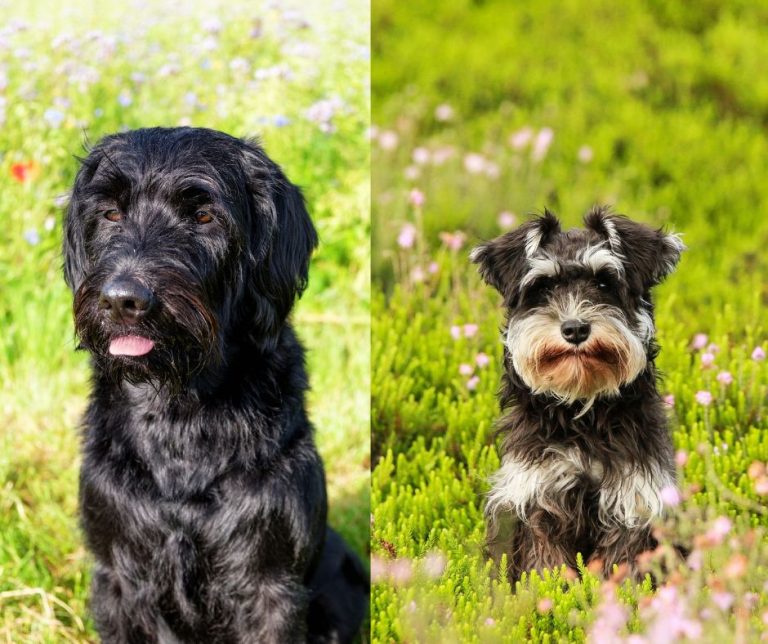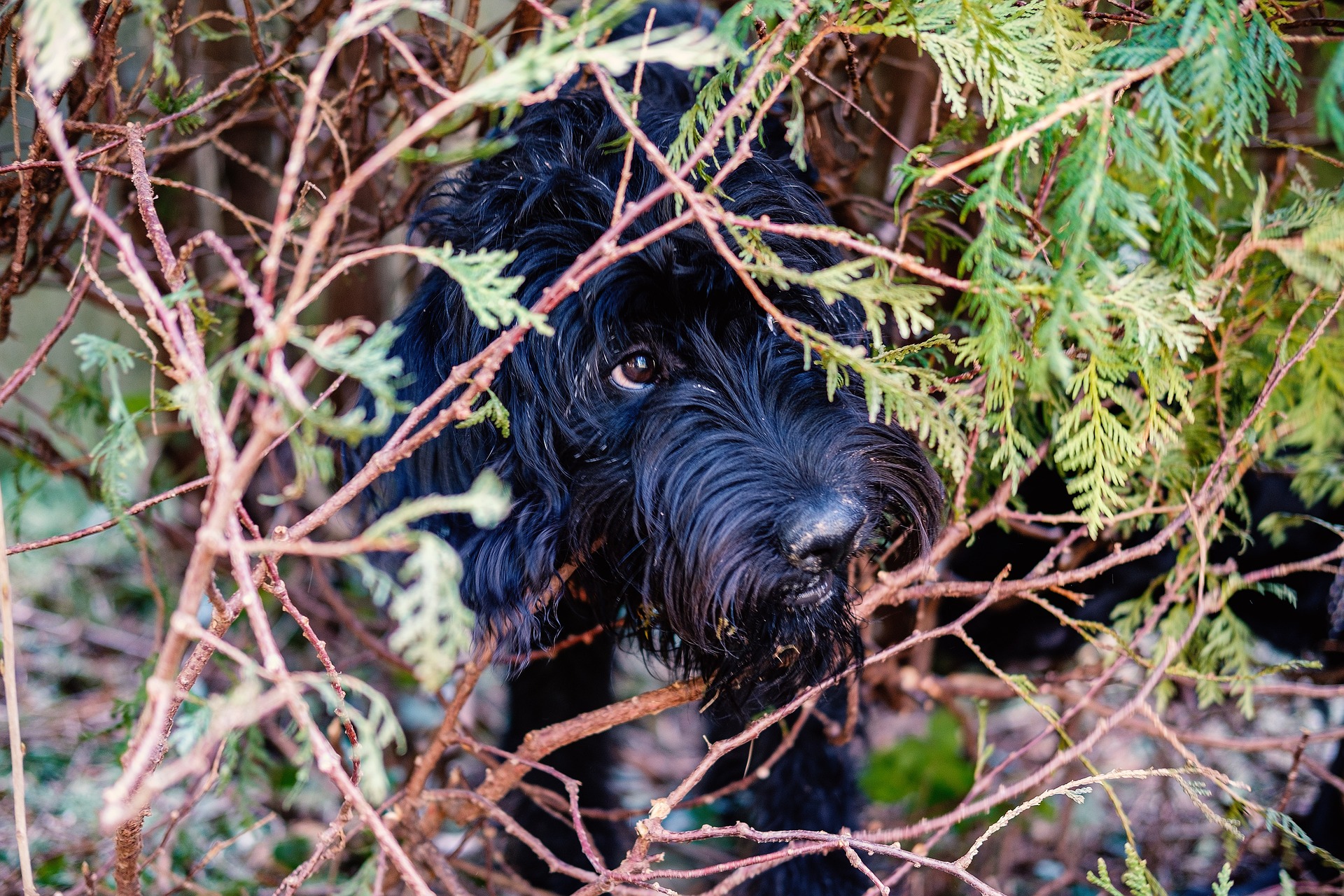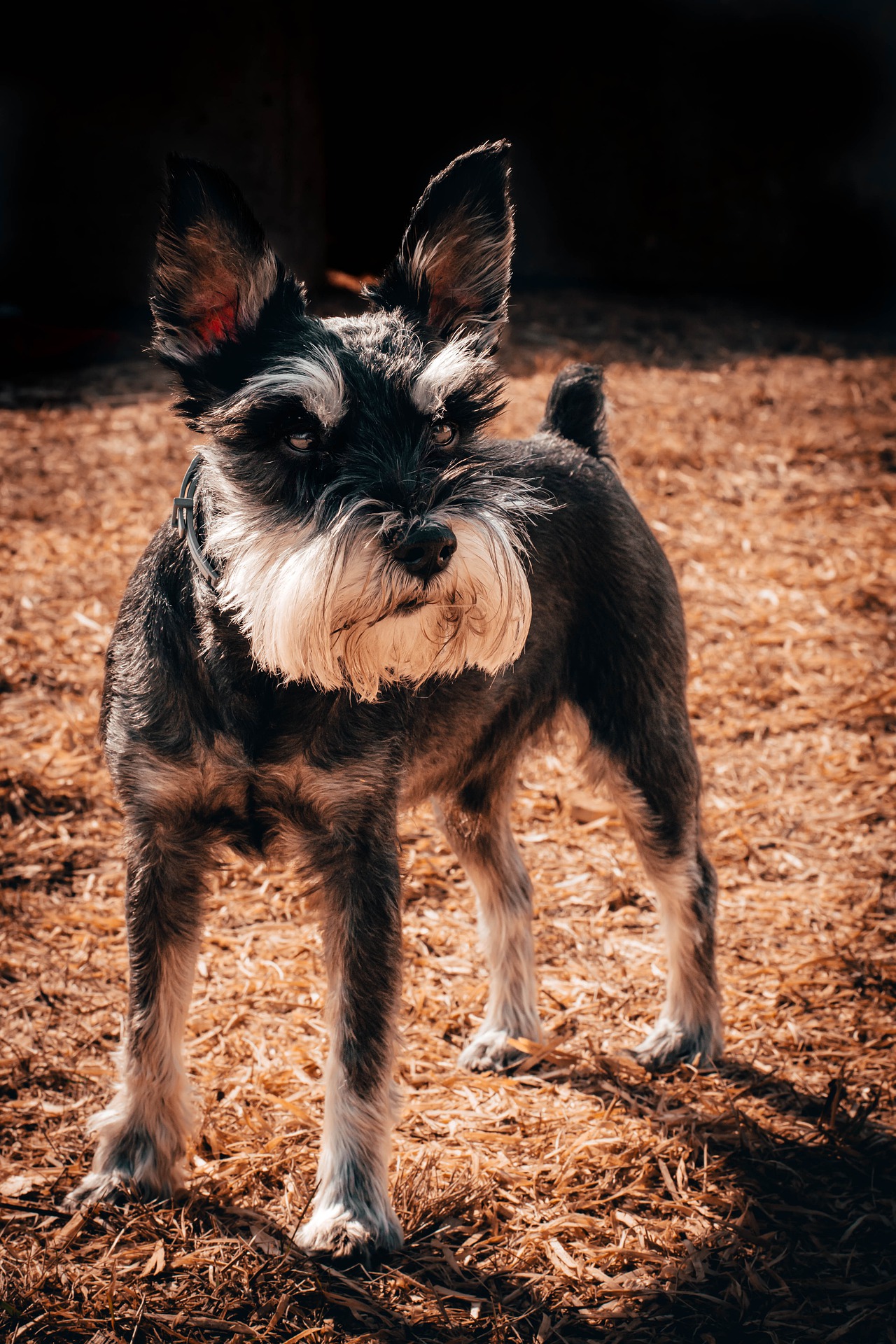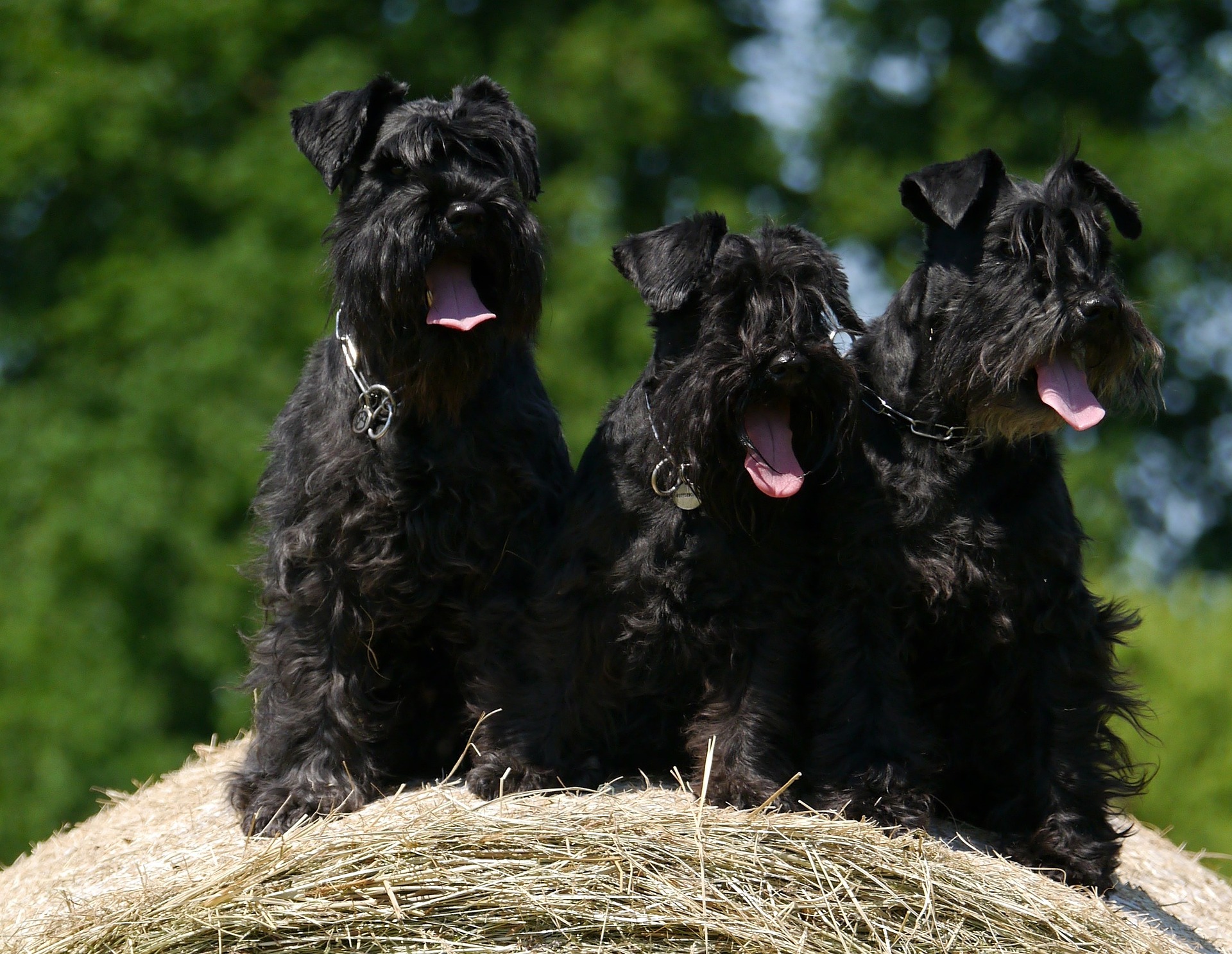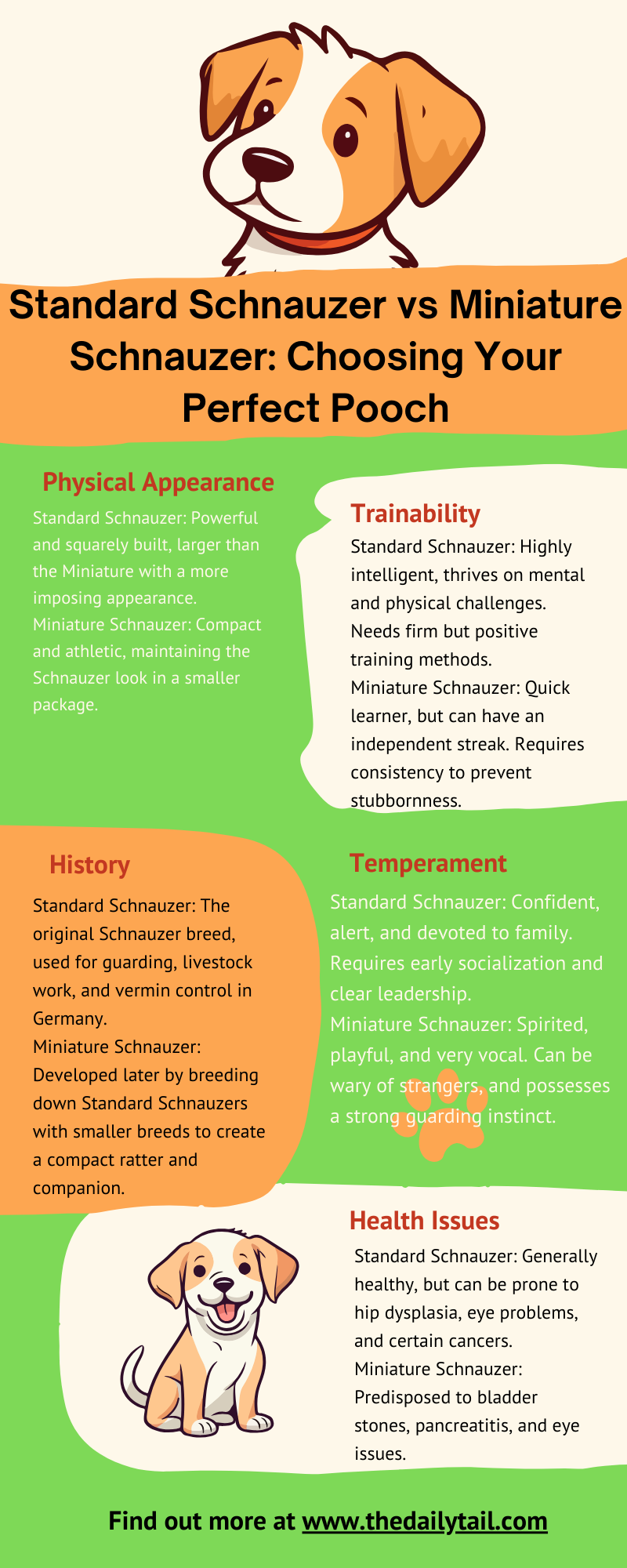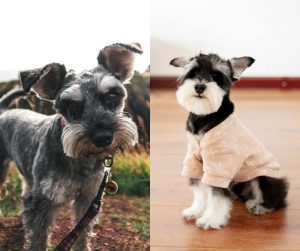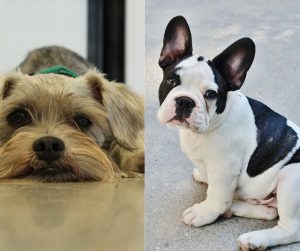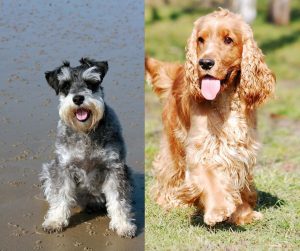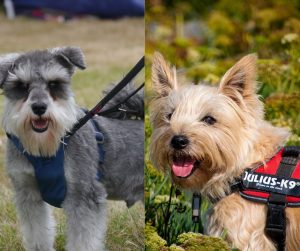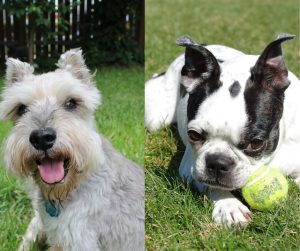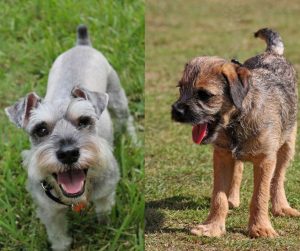As a lifelong Schnauzer lover, I understand the unique differences between the stately Standard and the spirited Miniature. Let’s delve into what sets them apart.
Schnauzers possess a distinctive charm that sets them apart in the canine world, with their trademark beards and spirited personality. The Standard Schnauzer and the Miniature Schnauzer share many traits but differ in ways that affect their suitability as pets in different living environments.
The Standard Schnauzer is part of the Working Group and cuts a larger, more robust figure, often requiring more exercise and space. On the other hand, the Miniature Schnauzer, classified within the Terrier Group, offers a compact size and spirited character, making it an appealing option for those with limited space.
Understanding the nuances between the Standard and Miniature Schnauzers goes beyond size; it extends to their care needs, their adaptability to family life, and their health considerations. While the Standard Schnauzer may be more vocal and high-energy, necessitating a more active lifestyle, the Miniature Schnauzer can be more reserved initially, yet both breeds are known for their intelligence and trainability.
Prospective owners should consider these characteristics to ensure a mutual fit that promotes a healthy, happy relationship with their furry companion. Don’t be fooled by the beard! While sharing a name, Standard and Miniature Schnauzers are suited to different lifestyles. Let’s explore why size isn’t everything.
Key Takeaways
- Standard and Miniature Schnauzers share family traits but have different exercise and space requirements
- Each breed exhibits distinctive personality traits and training aptitudes, reflecting their group classifications
- Prospective pet owners must consider their own lifestyle when choosing the right Schnauzer for their home
Breed Origin and History
When diving into the histories of the Standard Schnauzer vs Miniature Schnauzer, we have to go back to their rich tapestry woven into Germany‘s past. These dogs, originally bred for functional purposes, have evolved into beloved companions.
Standard Schnauzer Origin
The Standard Schnauzer is the prototype of the Schnauzer breed, with a history stretching back to the Middle Ages in Germany. Images from the 14th century first showcase dogs bearing a striking resemblance to today’s Standard Schnauzers. These dogs were initially bred as ratters, employed to protect farms and homes from vermin. Over time, they gained a reputation as steadfast guardians and companions.
Key Historical Points for the Standard Schnauzer:
- Timeframe: Appeared in the 14th century
- Origin: Germany
- Purpose: Vermin control and guarding
- Weight: Approximately 40-60 pounds
Miniature Schnauzer Development
Developed in the late 19th century, the Miniature Schnauzer is a smaller version of the Standard Schnauzer. German breeders downsized the Standard to create a more compact ratter that could excel in urban settings. Despite their reduced stature, typically weighing 15-20 pounds, these Miniature Schnauzers retained their predecessor’s work ethic and versatility.
Key Historical Points for the Miniature Schnauzer:
- Development: Late 19th century
- Origin: Adapted in Germany
- Purpose: Adapted for urban ratting
- Weight: Approximately 15-20 pounds
Both Schnauzers have transitioned well from their humble beginnings as ratters to becoming cherished pets who are just as happy curling up on the couch as they are performing the jobs they were bred for.
Physical Characteristics and Appearance
When choosing between a Standard Schnauzer and a Miniature Schnauzer, it’s important to understand how they differ in their looks. Both breeds share a distinguished appearance with their iconic bearded snouts but vary greatly in size and coat. We have to note that the American Kennel Club doesn’t make a distinction between the two Schnauzer breed dogs. They recognized the dog breed, but sizes can vary.
Size and Weight
Standard Schnauzer
- Height (Adult): 17.5-19.5 inches
- Weight (Adult): Males 35-50 pounds; Females 30-45 pounds
Miniature Schnauzer
- Height (Adult): 12-14 inches
- Weight (Adult): Males 13-20 pounds; Females 11-15 pounds
These numbers clearly show that the Standard Schnauzer is the larger breed, quite robust and sturdy, suitable for those who enjoy a more substantial companion. The Miniature Schnauzer, on the other hand, fits perfectly into lapdog status, making them an ideal pick for apartment living or anyone with limited space.
Coat Texture and Colors
Texturally, both breeds possess a wiry outer coat with a soft undercoat, which lends itself to the rugged yet refined appearance they’re known for. Grooming is essential to maintain this distinctive coat and keep them looking dapper.
Standard Schnauzers generally come in:
- Pepper and Salt
- Pure Black
While Miniature Schnauzers can be found sporting the same hues, they are also known for additional colors such as:
- Black and Silver
- White
Their coat not only adds to their charm but also to their appeal to families with allergy concerns due to its hypoallergenic qualities.
In terms of their ears, both breeds may have ears that stand erect or are neatly folded, contributing to their alert and spirited expression. No matter which Schnauzer one chooses, their appearance is sure to turn heads and their coats will require regular care to remain tidy and healthy.
Personality and Temperament
When choosing between a Standard Schnauzer and a Miniature Schnauzer, understanding their distinct personalities and temperaments is crucial. They may share a breed name, but their characteristics cater to different family environments and lifestyles.
Behavioral Traits
Standard Schnauzers are known for their protective instincts, making them excellent watchdogs. They are steadfast and intelligent, taking their role as a family protector seriously. These dogs thrive on mental and physical challenges and exhibit a loyal and alert demeanor.
- Temperament: Protective, Loyal, Alert
- Best Suited for: Active individuals or families, those seeking a watchdog
- Requires: Ample mental and physical exercise
In contrast, Miniature Schnauzers are spirited and often more playful. Though they can also be alert like their larger counterpart, they tend to have an adaptable personality that fits well into many home environments.
- Temperament: Playful, Friendly, Affectionate
- Best Suited for: Families, Multi-pet households, Those new to dog ownership
- Requires: Daily playtime, consistent training
Interaction with Family
Both Schnauzers tend to be affectionate with their families; they cherish the companionship and are eager to please.
Standard Schnauzers might be more reserved around strangers. But once they warm up, they are just as friendly and capable of forming strong bonds. Their loyalty makes them particularly attached to family members. They are good with children but due to their size and energy levels, interaction with smaller children should be supervised.
Miniature Schnauzers, smaller in size, are typically very playful and might be a better option for families with younger children. They tend to be more welcoming of strangers and can juggle the roles of a companion pet and a mild watchdog. They get along well with other pets, especially when introduced at a young age.
In both breeds, early socialization and training are key in shaping a well-mannered and sociable dog. A clear distinction is that the Miniature’s size and temperament make it well-suited to the indoors and thus adaptable to various living situations, including apartments. Meanwhile, the Standard’s robust build and energy level make it ideal for those with more space and time to fulfill its exercise needs.
Exercise and Training
Choosing between a Standard Schnauzer and a Miniature Schnauzer often comes down to the potential owner’s lifestyle, particularly when it comes to exercise and training needs. These energetic canines crave play and mental challenges to stay happy and healthy.
Activity Level and Energy
Standard Schnauzers are known for their high energy levels and typically need more exercise—up to two hours a day. They thrive on being busy and love activities like agility and obedience trials that challenge their bodies and minds. On the other hand, Miniature Schnauzers possess a spirited energy that can be satisfied with shorter, more frequent play sessions. An hour of exercise a day usually suffices for this smaller version, though they too enjoy a good mental workout through play and other stimulating activities.
Trainability and Mental Stimulation
Both the Standard and Miniature Schnauzer rank high in intelligence, which makes them easy to train with the right approach. Using positive reinforcement techniques works well for both breeds. These dogs are eager to please, and they latch onto obedience training with enthusiasm. Mental stimulation is as crucial as physical exercise, otherwise, they may find less desirable ways to alleviate boredom. The Miniature may have a slight edge in agility due to its smaller size, but both sizes enjoy and excel in training activities that engage their clever minds.
Grooming and Care
When it comes to the Schnauzers, whether you share your home with a Standard or a Miniature, each of them requires a fair amount of grooming to keep their wiry coats in top-notch condition. Their distinctive appearance with the prominent whiskers is a hallmark of the breed, and maintaining that groomed look is part of the joy and responsibility of owning these charming dogs.
Coat Maintenance
Standard Schnauzer:
- They possess a dual coat, with a wiry outer layer and a soft undercoat
- Regular brushing, about two or three times a week, is needed to prevent mats and tangles
- Grooming needs: Professional grooming every 5-8 weeks is recommended to maintain their harsh, wiry coat, which is a protective characteristic of the dog breed
Miniature Schnauzer:
- Despite their smaller size, Mini Schnauzers have a dense, wiry coat similar to their larger counterparts
- Hypoallergenic: Both breeds are considered hypoallergenic, as they are non-shedding, making them a preferable option for allergy sufferers
- Coat care includes frequent brushing, but Miniature Schnauzers might require more regular grooming sessions due to their size and the quickness with which their coat can become unkempt
Nail and Dental Care
Both the Standard and Miniature Schnauzer need regular nail trims to prevent overgrowth and splitting, which can be uncomfortable and lead to problems walking. Their nails should be checked and trimmed, if necessary, approximately once a month.
As for their dental health, these Schnauzers benefit from routine teeth brushing to avoid plaque buildup and to prevent dental issues. Incorporating this into their daily routine can go a long way in ensuring their teeth remain healthy.
Given their expressive faces, special attention should be paid to the whiskers and beard around the mouth, which can trap food and debris. Keeping this area clean is not just about aesthetics; it’s about hygiene as well.
Health and Lifespan
When considering a furry companion, one of the most poignant differences between the Standard Schnauzer and the Miniature Schnauzer are their health concerns and expected lifespans. They share some health risks yet also face breed-specific issues. Potential owners should be aware to ensure these pooches live long, happy lives.
Common Health Issues
Both breeds can be hearty, but they’re not without their troubles. Here are some affections to keep an eye out for:
Standard Schnauzer:
- Hip Dysplasia: A genetic condition causing abnormal hip joint development, leading to arthritis or lameness
- Cataracts: Can lead to impaired vision and potentially blindness
Miniature Schnauzer:
- Bladder Stones: Miniature Schnauzers may develop urinary stones, which can cause discomfort or require surgical intervention
- Obesity: A common issue that can exacerbate other health problems
Both breeds may also experience:
- Allergies: Can manifest as skin irritations or dietary sensitivities
Maximizing Health and Wellness
To support a Schnauzer’s best life, consider these wellness tips:
Standard Schnauzer:
- Exercise: Daily activity is key; aim for at least 1 hour to keep them fit and stave off obesity
- Regular Vet Checks: Early detection of health issues such as hip dysplasia and cataracts can make a significant difference
Miniature Schnauzer:
- Diet Control: To prevent bladder stones and obesity, a well-balanced diet is crucial
- Grooming: While not directly health-related, proper grooming can help identify skin allergies early on
For all Schnauzers, staying informed on breed-specific issues allows one to be proactive about their health. Regular vet visits, a proper diet, exercise, and lots of love are the cornerstones of a long, healthy life for these charismatic companions.
Suitability as a Pet
Selecting between a Standard Schnauzer and a Miniature Schnauzer as a family pet comes down to understanding their distinct traits and assessing how well these align with your home life and routine.
Ideal Home Environment
Standard Schnauzers are energetic and need ample room to play and explore, making them suitable for more spacious homes with backyards. They have a protective nature, serving well as guard dogs and watchdogs, alert to changes in their environment. As farm dogs, their diligence comes in handy for owners living in rural areas.
Miniature Schnauzers, while still active, adapt well to apartment living due to their smaller size. This breed craves interaction, fitting nicely into a lifestyle that accommodates regular companionship. As enthusiastic companions, they tend to follow their owners around the home.
Compatibility with Other Pets
The Standard Schnauzer’s temperament may be reserved initially, so introducing them to other pets, especially cats, should be done with care to ensure a harmonious environment. Patience and controlled introductions can help them become comfortable with other animals.
In contrast, Miniature Schnauzers are generally suitable for homes with other pets given their friendly and sociable nature. They are often eager to please, which can make training them to coexist with other pets a smoother process. Nevertheless, as both breeds may have a prey drive, supervision is always recommended, especially in the beginning.
Choosing the Right Schnauzer
When it comes to welcoming a new dog into your home, understanding the differences between a Standard Schnauzer vs Miniature Schnauzer dog is crucial. They might look similar with their distinctive beards and eyebrows, but they’re suited to different living situations and companions.
Deciding Between Standard and Miniature
The Standard Schnauzer and the Miniature Schnauzer differ in size, temperament, and energy levels. Here’s a quick guide to help you understand these key differences:
- Size:
- Standard Schnauzer puppy: Typically stands about 17.5 to 19.5 inches at the shoulder and weighs between 30 to 50 pounds
- Miniature Schnauzer puppy: Smaller, standing 12 to 14 inches at the shoulder, with a weight ranging from 11 to 20 pounds
- Temperament: Both breeds share a protective and lively nature, but the Standard tends to be more of a working dog with a need for consistent mental and physical stimulation, while the Miniature is often more adaptable to apartment living
- Energy Level:
- Standard Schnauzer: High energy, requires regular exercise and mental challenges
- Miniature Schnauzer: Still energetic but can be more suitable for less active owners due to its smaller size
When choosing which dog breed suits an individual’s lifestyle, considering these aspects is crucial. For those with ample space and time to dedicate to training and exercise, the Standard Schnauzer is an excellent choice. On the other hand, the Miniature Schnauzer might be better for individuals or families looking for a smaller, yet still spirited companion.
Finding a Reputable Breeder
Once the decision between a Standard Schnauzer and a Miniature Schnauzer has been made, the next step is finding a breeder who prioritizes the health and welfare of their puppies. Here are a few steps to take when researching breeders:
- Health Screenings: Ensure that the breeder conducts genetic health screenings and can provide health clearances for both parents
- Puppy Visits: A legitimate breeder will allow potential buyers to visit and see where the puppies are raised
- Questions: Breeders should be knowledgeable about the breed and willing to answer questions about the puppies’ temperaments, parental lineage, and care requirements
- Aftercare: A dedicated breeder provides support even after the puppy is taken home, offering guidance for any future concerns or questions
When selecting a breeder, it’s not just about the puppies, but also about choosing someone who provides thorough, compassionate aftercare and demonstrates a deep understanding of the breed. Doing this groundwork ensures that the chosen puppy has the best start in life and that they’re the right fit for their new family.

